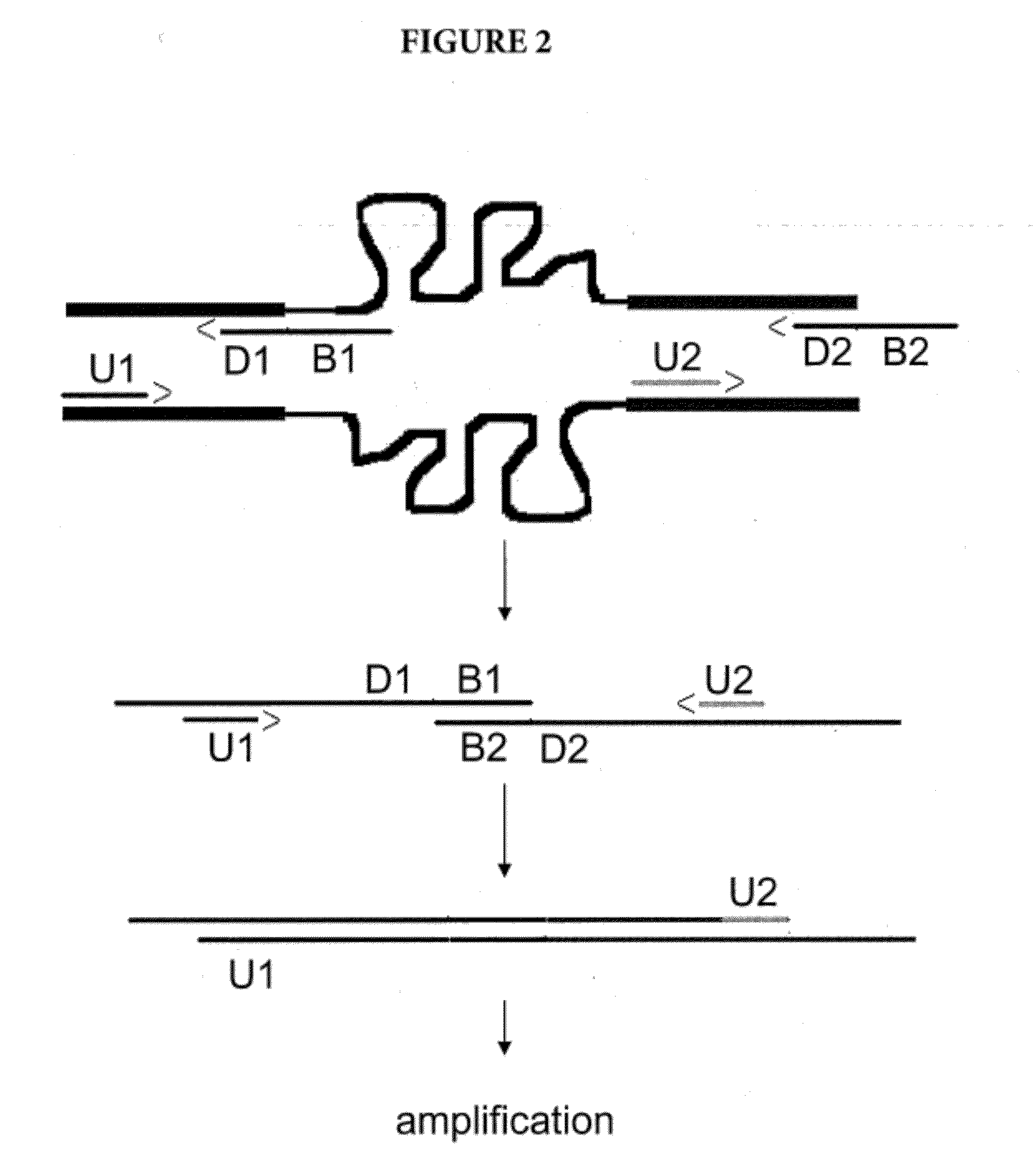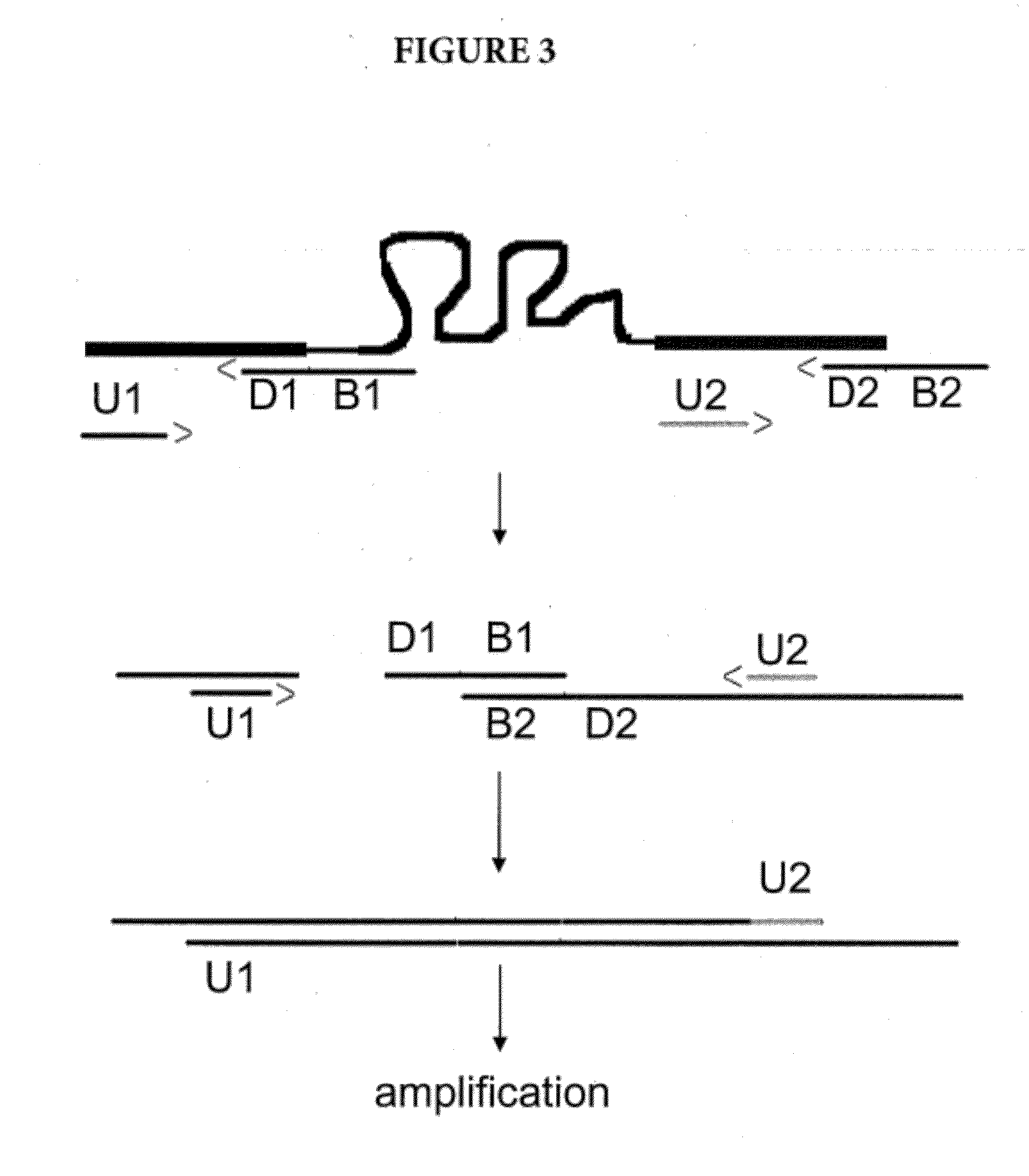Amplification of Distant Nucleic Acid Targets Using Engineered Primers
- Summary
- Abstract
- Description
- Claims
- Application Information
AI Technical Summary
Benefits of technology
Problems solved by technology
Method used
Image
Examples
example 1
Detection of a Pathogen Sequence (M. Tuberculosis) by Generating and Detecting an Amplicon Bridging Distant Sequences
[0080]In this example, the method was used detect the presence of M. tuberculosis (MTB) DNA in the sample. The example illustrates an MTB amplicon from partially overlapping oligos that bypasses the 564 by distance between highly conserved gene regions and generates a short amplicon (233 bp). The amplicon is tailored to the exact length desired and is designed to contain a TaqMan® probe-binding region.
[0081]For this example, the upstream and downstream primers and probes were selected from Table 1.
[0082]Each 50 μL amplification reaction contained 15 mM Tris, pH 8.5, 77 mM Tricine, 55 mM potassium hydroxide, 95 mM potassium acetate, 9.5% Glycerol (v / v), 1.15% DMSO, 0.58 mM each dATP, dCTP, dGTP and dUTP, 0.5 μM each upstream and downstream assay oligonucleotides, 0.1 μM upstream and downstream bridge oligonucleotides, 0.093 μM probe, 154 U / mL ZO5 DNA polymerase, 75 U / m...
example 2
Detection of the Pathogen Sequence (MRSA) by Generating and Detecting an Amplicon Combining Targets that are Further Apart on the Genome
[0085]In another example, the method of the present invention was successfully applied to S. aureus (MRSA). In that example, the target sequences orfX and mecA are separated by distances ranging from 2,500 to 50,000 base pairs, depending on the strain. Therefore, without the method of the present invention, the amplicon size would be not only unmanageably large, but also variable. The method of the present invention was able to bridge that distance and generate a short amplicon in all MRSA strains tested. Results are shown in FIG. 7.
[0086]For this example, the upstream and downstream primers were selected from Table 2. The reaction conditions were identical to those in the first example, and the cycling conditions were as follows: 2 min at 50° C., followed by 94° C. for five sec, followed by 55° C. for 2 min, followed by 60° C. for 6 min, followed b...
example 3
Detection of the Pathogen Sequence by Generating and Detecting an Amplicon Combining Targets that are Located on Separate Genomes
[0087]In this example, the method of the present invention was successfully applied to generate an amplicon combining the sequences of two bacterial species: methicillin-sensitive Staphylococcus aureus (MSSA) and methicillin-resistant Staphylococcus epidermidis (MRSE). For this example, the primers were selected from Table 2, and the reaction conditions were identical to those in the second example. Results are shown in FIG. 7.
[0088]While the invention has been described in detail with reference to specific examples, it will be apparent to one skilled in the art that various modifications can be made within the scope of this invention. Thus the scope of the invention should not be limited by the examples described herein, but by the claims presented below.
PUM
| Property | Measurement | Unit |
|---|---|---|
| Length | aaaaa | aaaaa |
Abstract
Description
Claims
Application Information
 Login to View More
Login to View More - R&D
- Intellectual Property
- Life Sciences
- Materials
- Tech Scout
- Unparalleled Data Quality
- Higher Quality Content
- 60% Fewer Hallucinations
Browse by: Latest US Patents, China's latest patents, Technical Efficacy Thesaurus, Application Domain, Technology Topic, Popular Technical Reports.
© 2025 PatSnap. All rights reserved.Legal|Privacy policy|Modern Slavery Act Transparency Statement|Sitemap|About US| Contact US: help@patsnap.com



